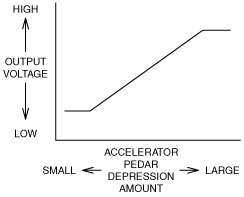STEP
INSPECTION
ACTION
1
Perform the road test.
(See ROAD TEST [DJVA-EL].)
Do all the transaxle functions operate properly?
Yes
Inspect the following:
• Restriction in air cleaner element (Replace to the new air cleaner temporarily)
• Ignition timing
• Ignition leak
• Spark plug
• Compression
• Valve timing
Repair or replace the malfunctioning part according to the inspection results.
No
The cause of symptom is in the CVT.
• Go to the next step.
2
Measure the APP sensor signal voltage using the M-MDS (PCM PIDs APP1 and APP2) or voltmeter.
Do the APP sensor signal voltages change linearly according to accelerator pedal position?
Yes
Go to the next step.

No
Repair or replace the malfunctioning part according to the inspection results.
3
Disconnect the TCM connector.
Measure the resistance between ground terminal at the TCM connector (terminal A1 and A23) and body ground.
Is the resistance less than 5.0 ohms?
Yes
Go to the next step.
No
Repair or replace the wiring harness for a possible open circuit.
4
Inspect the input signal circuit between following sensors and TCM:
• Oil pressure sensor
• Transaxle fluid temperature (TFT) sensor
• Input/turbine speed sensor
• Primary pulley speed sensor
• Secondary pulley speed sensor
• TR switch
• Grade sensor
Is there any malfunction?
Yes
Repair or replace the malfunctioning part according to the inspection results.
No
Go to the next step.
5
Inspect the following TCM output signal circuit:
• Belt grip pressure linear solenoid
• Shift control solenoid No.1
• Shift control solenoid No.2
Is there any malfunction?
Yes
Repair or replace the malfunctioning part according to the inspection results.
No
Go to the next step.
6
Inspect the following sensors:
• Oil pressure sensor
• Transaxle fluid temperature (TFT) sensor
• Input/turbine speed sensor
• Primary pulley speed sensor
• Secondary pulley speed sensor
• TR switch
• Grade sensor
Is there any malfunction?
Yes
Repair or replace the malfunctioning part according to the inspection results.
• If the transaxle fluid temperature (TFT) sensor has a malfunction:
-
― Replace the CVT.
No
Go to the next step.
7
Inspect the following solenoids:
• Belt grip pressure linear solenoid
• Shift control solenoid No.1
• Shift control solenoid No.2
Is there any malfunction?
Yes
Replace the CVT.
No
Replace the TCM.
8
• Verify the test results.
-
― If normal, return to the diagnostic index to service any additional symptoms.― If the malfunction remains, inspect the related Service Information and perform repair or diagnosis.
-
• If the vehicle is repaired, the symptom troubleshooting is completed.• If the vehicle is not repaired or additional diagnostic information is not available, replace the TCM. (See TCM REMOVAL/INSTALLATION [DJVA-EL].)
-